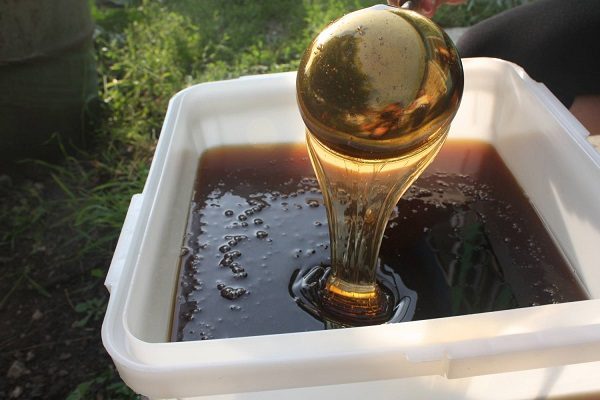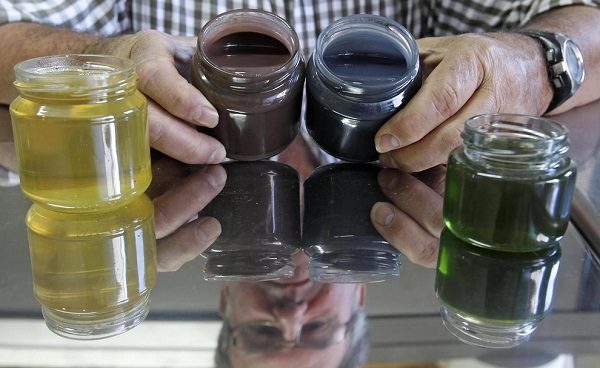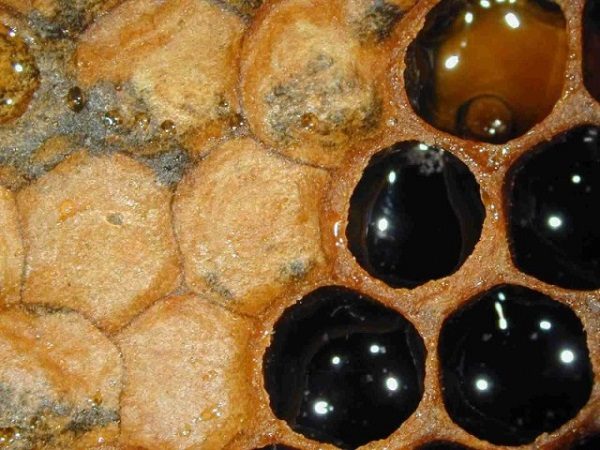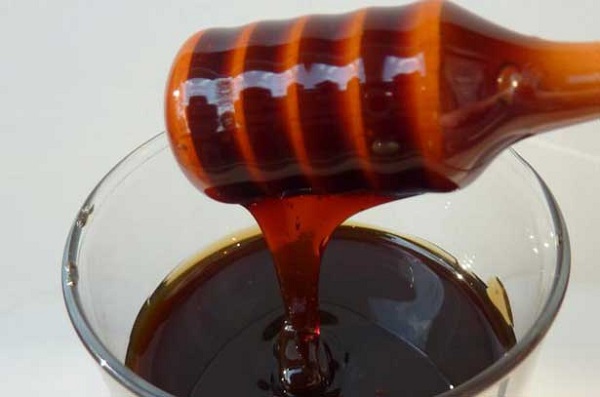If we buy honey in the market at the beginning of autumn or in hot August summer after no less hot July, then we are most likely dealing with fallen honey in a floral mixture. Although buckwheat and sunflower also bloom late, but the product of these honey plants is easily distinguished by smell, color and taste. Paddy honey has its own distinctive features.
In this article we will discuss what is honeydew honey, let's talk about its animal and vegetable origin.
Table of contents
Honeydew honey: what is it?
Honeydew honey has many colors and shades.It depends on the type of plants and insects from which the pad is taken, weather and climatic conditions. It is amber or dark greenish, if the source of the pad is the needles of trees.
But in most cases it has a dark brown or black color.
This is the first sign on which it is distinguished when buying. By its structure and consistency, this honey is similar to tar. It is viscous, stretching.
In all other cases, the sweetness of his little felt, but there is a taste of bitterness. Sometimes its taste is unpleasant and repulsive.
Differs in the increased hygroscopicity, therefore quickly sours. For long-term storage, it is not suitable. Crystallization takes place slowly, sometimes it does not exist or sludge of the liquid fraction occurs.
In the days of Tsarist Russia, they were forbidden to trade, as it was believed that this was a product of low grade and quality. The phrase "bezrybe and cancer - fish" - this is about honeydew. But it concerns the choice of the bee. If she even has to choose, she will give preference to flower nectar.
In Western Europe, honeydew honey is valued more than floral because of its beneficial properties. We traditionally prefer, like bees, a flowery look.

Ingredients: vitamins and minerals
The composition of honeydew honey is different. It depends on the honeydew from which the bees take a bribe. For example, honey collected from a pine needle is 5-6 times lower in phosphorus than from honeydew leaves.
The same applies to the potassium content. There are phytoncides in it, which are natural antibiotics. Mineral salts (iron, cobalt, phosphorus, manganese) are also abundant. According to these indicators, this variety exceeds the floral, so it is so valuable to humans.
There are a lot of polysaccharides in the honeycomb honey.. In addition, it contains fructose, sucrose, glucose, and other sugars. There are a lot of free amino acids. There are 3-4 times more protein in such honey than in flower. 100 grams of the product contains 324 calories. This is a high figure.
Benefit and harm
Provides invaluable benefits to the body. It is distinguished by antiseptic and bactericidal properties, is an excellent antidepressant. It restores strength increases overall body tone.
It is useful to take a weakened body, especially children after an illness or to increase immunity. It is used in traditional and alternative medicine, cosmetology.
The structure is destroyed, it stratifies, loses its color and attractiveness.. The taste also changes in the direction of increasing bitterness.

Contraindications for use
Due to its caloric content and a large amount of minerals, it is taken in moderation. Allergy sufferers are not recommended to take this variety, as it may harm the body. The same applies to people suffering from diabetes.
Daily consumption is limited to three times a day for one tablespoon. That is, the dose for an adult - 110-130 grams.
About honey plant
In too dry periods, bees take a drop for a bribe.It is of plant and animal origin. In the first case, it is a sweetish transparent liquid, which is secreted by plants (leaves and shoots).
Some call it "honeydew." If you have seen droplets of a colorless liquid on the leaves of trees in the morning hours, then this is not dew, but a vegetable fall. It is also of animal origin. These are waste products of insects that feed on plant sap, for example, plant lice.
But the bee, even in the absence of plant honey plants, will refuse to take the pad, if its composition does not exceed 4% of sucrose and there is a lack of aromatic substances.
You may be interested in the following articles on the topic of honey:
- How to cook propolis ointment at home.
- Medicinal properties royal jelly.
- Application drone milk for medicinal purposes.
- Everything about use of bee venom in pharmacology and cosmetology.
Storage conditions
Honeydew honey is stored poorly. This is due to its chemical composition and increased hygroscopicity. Therefore, we are not talking about long-term storage.
If you decide to stock them for future use, the requirements for storage conditions are common to all varieties.The main thing is to observe the temperature, and the humidity was within the normal range. In addition, it is undesirable to hit the honey in direct sunlight.
For short-term storage set the temperature in the region of 15 degrees Celsius. For long-term storage - around 7 degrees with a plus. Humidity keep at 60%. We use glass containers. As an exception - plastic.

Medicinal properties
Honeydew honey is used in medicine after surgery to restore a weakened body.
With the loss of blood to restore it, it will also be of great service. For those who suffer from joints, or suffering from intestinal lethargy, this type of honey is recommended. He will help better than the other.
Honeydew honey in all senses is a specific variety. Along with the disadvantages (poorly stored, does not have a pleasant aroma and delicate taste), it has healing properties due to the mineral substances, phytoncides and polysaccharides in the composition.

I now have the opportunity to buy honeydew honey for almost a penny. From the article I realized that it was suitable for food, but with great reservations.And if used in cosmetology? I love honey masks to do, and also honey anti-cellulite massage. Are there any restrictions for using honeydew honey in this case?
Tatyana, no, in this case there are no restrictions. For cosmetic purposes, you can use without restrictions.